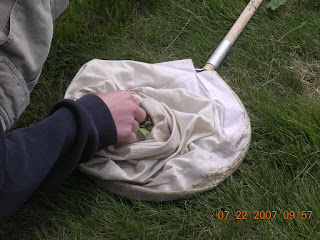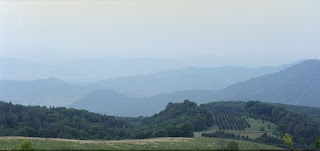Sunday, July 22, 2007
Appalachian Highlands Research Center || Sunday, July 22, 2007
This weekend wrapped up my time as a teacher intern for the All Taxa Biodiversity Inventory at Tremont. For the weekend, we hiked up to the Appalachian Highlands Research Center at Purchase Knob. Located on the Cataloochee side of the park (home to the reintroduced elk), we made the 7.5 mile trek up the mountain via the Caldwell Fork Trail, Boogerman Loop Trail, McKee Branch Trail (the last two miles of which were particularly brutal), and the Cataloochee Divide Trail. This is the first time I've hiked with a group of 12 teenagers, and that made the trip fairly interesting (it took 7.5 hours to hike the 7.5 miles... it's much more painful to hike slowly than quickly). On the trail there were signs of old homesites and large stands of virgin timber and old growth forest. Aside from a post lunch snack of Indian Cucumber, there were few ecology breaks due to the pacing, though one student spied a Fowlers Toad, a species that doesn't have a lot of recorded sightings on that side of the park.
After arriving at the research center, we met up with the other half of the group that had hiked the same route going the opposite direction to a car shuttle. We pitched our tents behind the AHRC (also called The Purchase), a former vacation home that was donated to the park in 2001 on the terms that it become a citizen science research center for both research and educational outreach.
On Saturday, we woke up and made the .7 mile walk down to the Ferguson Cabin, a late 19th century cabin that is the highest elevation historic cabin in the GSMNP. At the cabin, Paul Super, a park biologist specializing in birds, and Josh, from our group, had set up mist nets to capture birds for banding. The nets were very productive, as there were multiple birds on every net run. There were several cat birds (so called because of their call), 3+ ruby throated hummingbirds, and an Indigo Bunting. The birds were processed for sex, age, band information, and parasites, particularly mites and lice.
After banding, we walked further down the road to a transect of snake tins set up to study the home range preferences of the snakes found at The Purchase. Snakes found in the tins (a garter snake and a red belly) we processed for Snout to Vent length and for individual identification, which is done through clipping scales with a pair of scissors. Though not painful, scale clippings are relatively temporary as the scales grow back after several sheds. Following snake monitoring, we went back to the AHRC for lunch, followed in the afternoon by aquatic and terrestrial salamander monitoring in the creek behind the Ferguson Cabin. In an hour's time, we found, processed, and returned 39 aquatic and 3 terrestrial salamanders in 50 meters of stream. The terrestrial salamanders were found doing a leaf litter search on a 50 meter transect, while the aquatic monitoring was done, basically, by turning over every rock in a stream full of rocks, working our way up the stream as we went.
After salamanders, we went back to the research center while some groups of students began work on small group science projects, while others had freetime in preparation for supper. After eating, we set up a UV refrigerator moth trap and we went on a twilight owl prowl before heading to bed.
We woke up around 6:30 on Sunday morning to watch a hazy sunset, and after breakfast the students broke up into groups to work on their projects--a beetle mark and recapture project to estimate Japanese Beetle population size, a spider project, a snake project, and a moth project. After collecting data, the students were to go back to Tremont and continue research at a lower elevation to make comparisons. After all group projects were finished, we had lunch and went on our merry way.
Bartley (the other ATBI intern) and I, it is safe to say, probably took a path home no one had ever taken from Purchase Knob before. The trip to the Purchase took close to 4 hours, and we were determined to find a faster way. So...our 2 hour, 45 minute route, in case you ever need it: From Maggie Valley (home to Ghost Town in the Sky), hit I40W and go to Newport, take highway 411S to Sevierville, bypass Sevierville traffic taking backroads (Middle Creek Rd to Eastgate to Park Rd) to Pigeon Forge, and turn right at the Olive Garden/Red Lobster (New Era Rd), and take it to Walden Creek. If you turn right, you will go through East Millers Cove and eventually come out in Walland on Old Walland Highway relatively close to Wesley Woods. However, turning left on Walden Creek and then right on to Wears Valley Rd would probably be faster... but hey, we were feeling adventurous.
Subscribe to:
Post Comments (Atom)




























































No comments:
Post a Comment